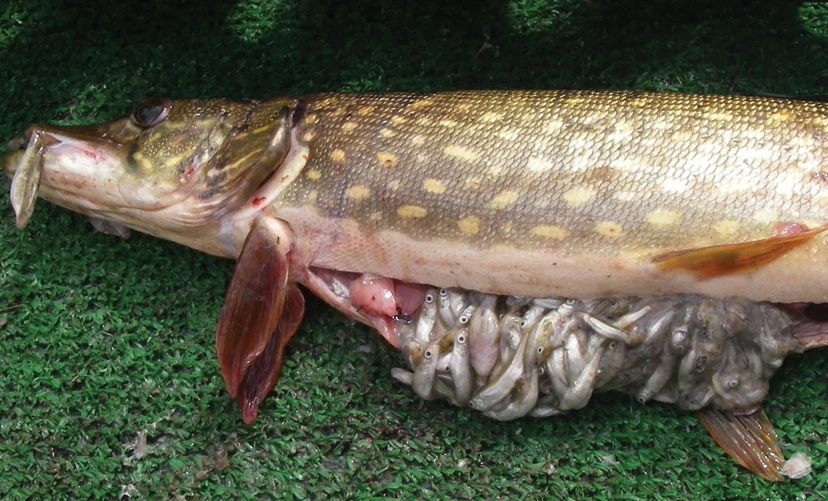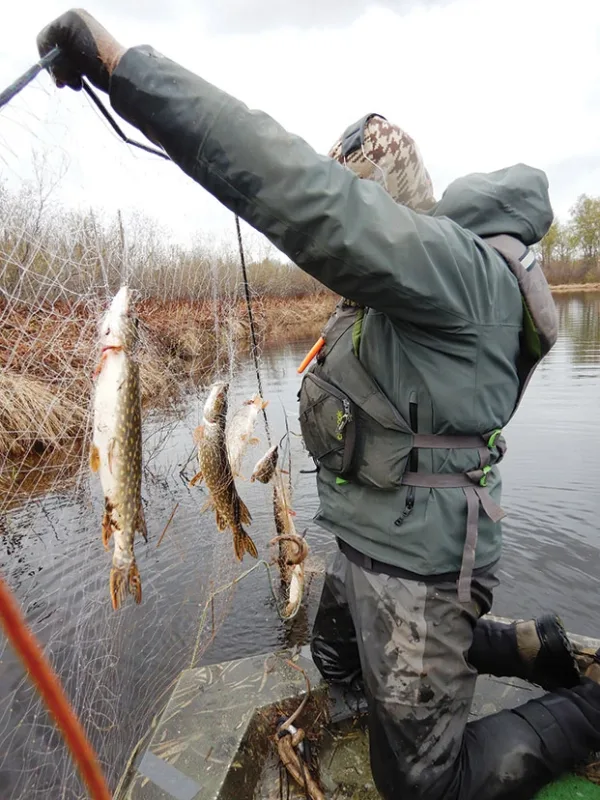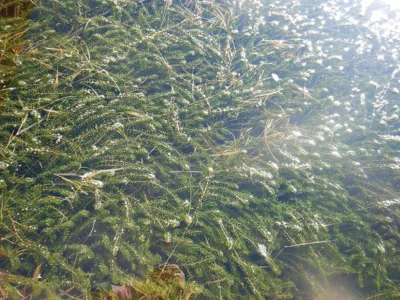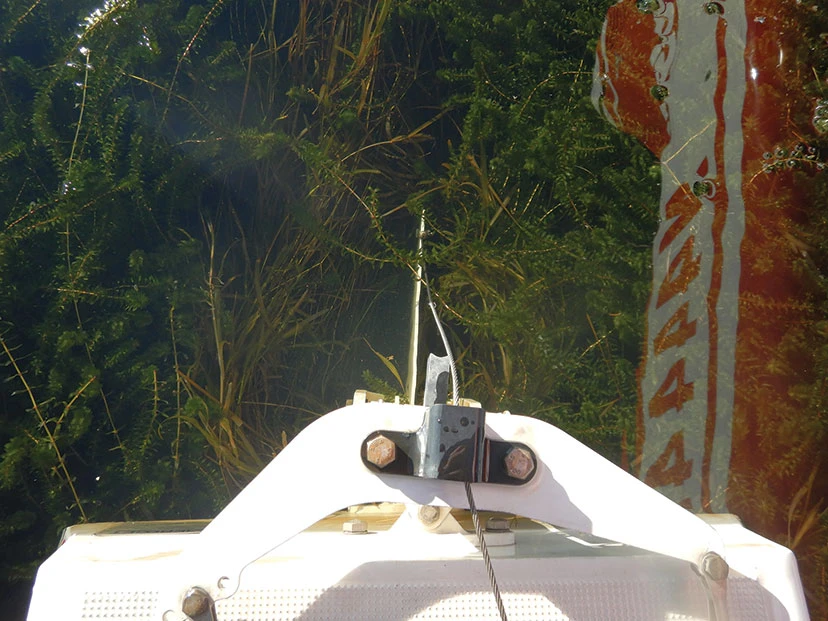Invasive species are very harmful to the ecosystem. This is especially critical in Alaska where salmon populations are being affected. What can individual anglers do to contribute to the mitigation efforts?

An invasive northern pike with a stomach full of salmon fry. Pike are decimating salmon and trout populations across southcentral Alaska.
Alaskans by nature love to recreate—to boat, hunt, fish, and hike—but by participating in these activities we can unknowingly harm the very places we cherish. How? By contributing to the spread of invasive species.
What are Invasive Species?

The Alaska Department of Fish and Game removes invasive pike by gillnetting.
First, what exactly are invasive species? Invasives are non-native plants, animals, fish, even bacteria, that cause harm to a given ecosystem, to the economy, or to human health. It’s important to note that not all non-native species are “invasives.” Take the plants for instance in our gardens. Most are non-native, but they are not invasive, in that they don’t have the ability to do harm. The broccoli plants we cultivate are unable to survive without our help and will never take over and snuff out native plants, plants that are key for providing habitat for a healthy ecosystem. Invasives, on the other hand, have traits that naturally allow them to not only survive, but to thrive and outcompete native species.
The Problem with Non-native Species
So, why is the introduction and spreading of these organisms so bad? Unlike that broccoli from your garden, plants such as elodea, a quick-growing non-native aquatic plant, have the ability to take hold and in doing so severely deteriorate the quality of water in lakes and streams and thus negatively affect fisheries. Unchecked, it can choke off waterways almost entirely, making it difficult to run boats or land planes, and thus significantly lowering the value of any adjacent land.
Some invasive species were brought intentionally. This was the case with pike being released into southcentral Alaska waters, where they are not normally found, or various flowers and trees planted by homeowners for ornamental reasons. Other invasives were transported unintentionally, perhaps hitching rides on our vehicles, equipment, boats, planes, fishing gear, boots, or firewood.
Displacing Native Flora and Fauna

Elodea displaces native flora and fauna, and degrades fish habitat.
It’s pretty obvious, with pike for instance, why the introduction of these voracious predators into salmon-bearing waterbodies is so bad, as they can effectively decimate entire populations of native salmon and trout in no time. But what about plants like elodea and reed canary grass? “They are just as bad if allowed to go unchecked,” says Maura Schumacher, currently an environmental scientist and Invasive Species Specialist with the Kenai Watershed Forum.
When prodded to pick one threat as the worst to Alaska, Schumacher hesitates. “Difficult to narrow down,” she says, “but right now reed canary grass (RCG) may be one of our biggest concerns. It’s a perennial grass that typically invades wetlands, constricting waterways, trapping silt and blocking passage for salmon. This has become a significant issue in other parts of the country, such as Washington state.” Plants such as RCG and elodea are a scourge and hated by floatplane pilots and fishers who have witnessed the damage they can inflict.
Invasive Marine Species
Also of concern are animals such as the European green crab, one of the most widespread invasive marine species on the planet, which has slowly been making its way up the west coast and has now been found in southeast Alaska. With very few predators they can easily take over, disturbing sediment and destroying important habitat for other crabs, such as Dungeness, as well as damaging critical habitat for salmon.
“Also on our radar,” says Schumacher, “are zebra and quagga mussels. They haven’t reached Alaska yet, but they are a big problem in other states.” They attach to boats, planes and even personal gear, and can survive for a long period. One was found during a recent inspection on a boat in Tok, Alaska. That boat had been pulled up from the Lower 48, where these filter feeders have shown up in various lakes, and where they basically pull all the nutrients out of the water, rendering them uninhabitable for most fish species, and thus in turn causing property values to plummet.
What is Being Done?
Invasives have become a major issue and concern for state water and land managers as well as borough entities and environmental organizations. The Alaska Invasive Species Partnership (AKISP) evolved from the work of various organizations and committees over the years. Initiated by the University of Alaska Fairbanks Cooperative Extension Service, the partnership now includes numerous entities, including federal and state agencies, tribal organizations, and various nonprofits. There is an annual workshop and committees on RCG, elodea, pike, and marine invasives. They host a list-serve where people can ask questions and be directed to groups active in their local area. On the Kenai Peninsula, for instance, we have the Cooperative Invasive Species Management Area (KP-CISMA), which is available to answer questions and holds volunteer seminars throughout the year.
This brings us to what we can do as individuals. There is a lot. First, never release aquarium fish or plants, or exotic animals into the wild. Verify that the plants purchased for landscaping and gardens are not invasives. Make sure boats, boots and waders are clean and dry before taking them to a different body of water. Ensure there are no invasive aquatic plants or animals hanging onto boat trailers or floatplane floats and rudders. Check your ATVs and trailers for terrestrial invasive plants and remove them before traveling.

Elodea can be transported by float planes and boats. Always clean, drain and dry your equipment between visits to different water bodies.
How can you help?
Get involved. For more information go to the AKISP (alaskainvasives.org) and KP-CISMA (kenaiinvasives.org) websites or better yet attend a local training and learn to identify invasives. Those of us who spend a great deal of time outdoors can be a huge help to the organizations trying to eradicate these destructive plants and animals. State and local groups have various means to report suspected invasives. Check out AKISP or a CISMA and join the vast volunteer effort to identify and rid ourselves of these invaders.
“It’s very difficult,” says Schumacher, “to stop an invasive once it really takes hold, but if we can stave off an infestation or catch it at an early stage of introduction it’s so much easier and more cost effective. We are lucky here in Alaska,” she adds, “being so far ahead of the rest of the country at this point, still having the ability to protect and care for our state.” But early detection is the key. And that is up to all of us, the hunters, fishers, hikers, and citizen scientists using the ability to report something new or seemingly out of place, so that invasive species managers are able to take swift action and prevent further spread, protecting our valuable fish and wildlife resources.
Dave Atcheson is based in Sterling and works for Trout Unlimited Alaska. He is also the author of several books, including Hidden Alaska, Dead Reckoning, and Canoeing Yaghanen. For more info: daveatcheson.com.
Invasive species are just one piece of the conservation puzzle in Alaska.
For more fish habitat conservation reading, check out Fish Alaska’s Conservation blog archive.
